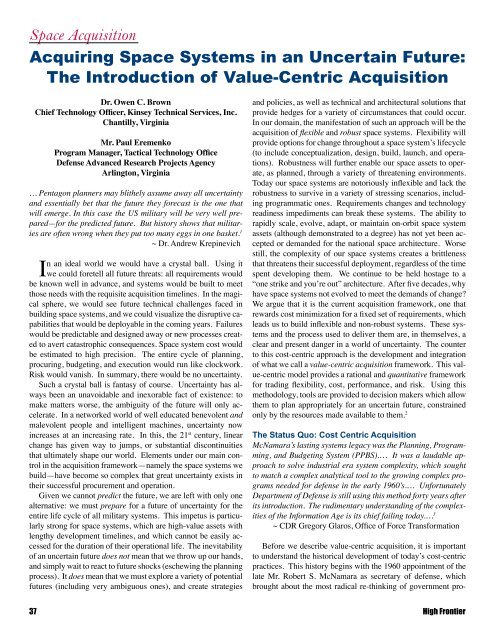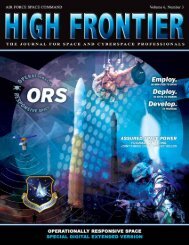Space Acquisition - Air Force Space Command
Space Acquisition - Air Force Space Command
Space Acquisition - Air Force Space Command
You also want an ePaper? Increase the reach of your titles
YUMPU automatically turns print PDFs into web optimized ePapers that Google loves.
<strong>Space</strong> <strong>Acquisition</strong><br />
Acquiring <strong>Space</strong> Systems in an Uncertain Future:<br />
The Introduction of Value-Centric <strong>Acquisition</strong><br />
Dr. Owen C. Brown<br />
Chief Technology Officer, Kinsey Technical Services, Inc.<br />
Chantilly, Virginia<br />
Mr. Paul Eremenko<br />
Program Manager, Tactical Technology Office<br />
Defense Advanced Research Projects Agency<br />
Arlington, Virginia<br />
… Pentagon planners may blithely assume away all uncertainty<br />
and essentially bet that the future they forecast is the one that<br />
will emerge. In this case the US military will be very well prepared—for<br />
the predicted future. But history shows that militaries<br />
are often wrong when they put too many eggs in one basket. 1<br />
~ Dr. Andrew Krepinevich<br />
In an ideal world we would have a crystal ball. Using it<br />
we could foretell all future threats: all requirements would<br />
be known well in advance, and systems would be built to meet<br />
those needs with the requisite acquisition timelines. In the magical<br />
sphere, we would see future technical challenges faced in<br />
building space systems, and we could visualize the disruptive capabilities<br />
that would be deployable in the coming years. Failures<br />
would be predictable and designed away or new processes created<br />
to avert catastrophic consequences. <strong>Space</strong> system cost would<br />
be estimated to high precision. The entire cycle of planning,<br />
procuring, budgeting, and execution would run like clockwork.<br />
Risk would vanish. In summary, there would be no uncertainty.<br />
Such a crystal ball is fantasy of course. Uncertainty has always<br />
been an unavoidable and inexorable fact of existence: to<br />
make matters worse, the ambiguity of the future will only accelerate.<br />
In a networked world of well educated benevolent and<br />
malevolent people and intelligent machines, uncertainty now<br />
increases at an increasing rate. In this, the 21 st century, linear<br />
change has given way to jumps, or substantial discontinuities<br />
that ultimately shape our world. Elements under our main control<br />
in the acquisition framework—namely the space systems we<br />
build—have become so complex that great uncertainty exists in<br />
their successful procurement and operation.<br />
Given we cannot predict the future, we are left with only one<br />
alternative: we must prepare for a future of uncertainty for the<br />
entire life cycle of all military systems. This impetus is particularly<br />
strong for space systems, which are high-value assets with<br />
lengthy development timelines, and which cannot be easily accessed<br />
for the duration of their operational life. The inevitability<br />
of an uncertain future does not mean that we throw up our hands,<br />
and simply wait to react to future shocks (eschewing the planning<br />
process). It does mean that we must explore a variety of potential<br />
futures (including very ambiguous ones), and create strategies<br />
and policies, as well as technical and architectural solutions that<br />
provide hedges for a variety of circumstances that could occur.<br />
In our domain, the manifestation of such an approach will be the<br />
acquisition of flexible and robust space systems. Flexibility will<br />
provide options for change throughout a space system’s lifecycle<br />
(to include conceptualization, design, build, launch, and operations).<br />
Robustness will further enable our space assets to operate,<br />
as planned, through a variety of threatening environments.<br />
Today our space systems are notoriously inflexible and lack the<br />
robustness to survive in a variety of stressing scenarios, including<br />
programmatic ones. Requirements changes and technology<br />
readiness impediments can break these systems. The ability to<br />
rapidly scale, evolve, adapt, or maintain on-orbit space system<br />
assets (although demonstrated to a degree) has not yet been accepted<br />
or demanded for the national space architecture. Worse<br />
still, the complexity of our space systems creates a brittleness<br />
that threatens their successful deployment, regardless of the time<br />
spent developing them. We continue to be held hostage to a<br />
“one strike and you’re out” architecture. After five decades, why<br />
have space systems not evolved to meet the demands of change<br />
We argue that it is the current acquisition framework, one that<br />
rewards cost minimization for a fixed set of requirements, which<br />
leads us to build inflexible and non-robust systems. These systems<br />
and the process used to deliver them are, in themselves, a<br />
clear and present danger in a world of uncertainty. The counter<br />
to this cost-centric approach is the development and integration<br />
of what we call a value-centric acquisition framework. This value-centric<br />
model provides a rational and quantitative framework<br />
for trading flexibility, cost, performance, and risk. Using this<br />
methodology, tools are provided to decision makers which allow<br />
them to plan appropriately for an uncertain future, constrained<br />
only by the resources made available to them. 2<br />
The Status Quo: Cost Centric <strong>Acquisition</strong><br />
McNamara’s lasting systems legacy was the Planning, Programming,<br />
and Budgeting System (PPBS).… It was a laudable approach<br />
to solve industrial era system complexity, which sought<br />
to match a complex analytical tool to the growing complex programs<br />
needed for defense in the early 1960’s.… Unfortunately<br />
Department of Defense is still using this method forty years after<br />
its introduction. The rudimentary understanding of the complexities<br />
of the Information Age is its chief failing today.… 3<br />
~ CDR Gregory Glaros, Office of <strong>Force</strong> Transformation<br />
Before we describe value-centric acquisition, it is important<br />
to understand the historical development of today’s cost-centric<br />
practices. This history begins with the 1960 appointment of the<br />
late Mr. Robert S. McNamara as secretary of defense, which<br />
brought about the most radical re-thinking of government pro-<br />
37 High Frontier











